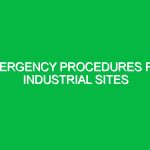In the ever-evolving landscape of the energy sector, safety compliance is not just a regulatory box to check; it is a foundational element that safeguards lives, properties, and the environment. As energy production and distribution continue to grow, the risks associated with this sector also escalate, making a robust health, safety, and environment (HSE) framework more critical than ever. This article explores the intricacies of safety compliance for the energy sector, delving into potential hazards, best practices, and the regulatory landscape that governs this vital industry.
Understanding Safety Compliance for Energy Sector
At its core, safety compliance for the energy sector refers to adhering to laws, regulations, and guidelines designed to protect the health and safety of workers, the public, and the environment. It encompasses a wide range of activities, from risk assessment and hazard mitigation to emergency response planning and environmental stewardship. The primary goal is to minimize accidents and incidents while ensuring operational efficiency.
In the energy sector, where the stakes are high and the potential for catastrophic events is significant, the relevance of safety compliance cannot be overstated. A lapse in compliance can lead to severe consequences, including loss of life, environmental degradation, and substantial financial penalties. For instance, the Deepwater Horizon oil spill of 2010 serves as a grim reminder of what can happen when safety protocols are ignored. This incident not only claimed 11 lives but also resulted in billions of dollars in damages and long-lasting environmental impact.
Identifying Hazards and Risks in the Energy Sector
The energy sector is fraught with various hazards, each presenting unique risks that require careful consideration. Understanding these hazards is the first step towards achieving effective safety compliance. Below are some of the most prevalent risks associated with the energy sector:
1. Chemical Hazards
Energy production often involves the handling of hazardous materials such as fuels, lubricants, and chemicals used in processes like fracking or refining. Exposure to these substances can lead to acute or chronic health issues, including respiratory problems, skin diseases, or even chemical burns.
2. Physical Hazards
The physical environment in energy facilities can be dangerous. Workers may encounter high-voltage equipment, heavy machinery, and moving vehicles. Falls, being struck by objects, and electrical shocks are just a few examples of the risks associated with physical hazards.
3. Environmental Hazards
Environmental risks include spills, leaks, and emissions that can harm the surrounding ecosystems. For instance, oil spills can have devastating effects on marine life, while emissions from fossil fuel combustion contribute to air pollution and climate change.
4. Psychological Hazards
While often overlooked, psychological risks can significantly affect worker safety. Stress, fatigue, and mental health issues can impair decision-making and reaction times, leading to accidents. The demanding nature of energy sector jobs can exacerbate these issues, necessitating a focus on mental well-being.
5. Regulatory Compliance Risks
With numerous regulations governing the energy sector, staying compliant can be challenging. Failure to adhere to these regulations can result in fines, lawsuits, and even shutdowns. Thus, understanding the regulatory landscape is essential for maintaining safety compliance.
Implementing Safety Precautions and Best Practices
Having identified the potential hazards, it is crucial to establish safety precautions and best practices that mitigate these risks. Here are some actionable strategies:
1. Comprehensive Risk Assessment
Regular risk assessments are vital for identifying hazards and evaluating their potential impacts. This process should involve all stakeholders, including management and frontline workers, to ensure a holistic understanding of the risks.
2. Training and Education
Workers must receive thorough training on safety protocols, emergency procedures, and the proper handling of hazardous materials. For example, regular drills for fire safety and spill response can prepare employees for real-life emergencies, enhancing their readiness and confidence.
3. Personal Protective Equipment (PPE)
Employers should provide appropriate PPE, such as helmets, gloves, goggles, and respiratory protection, tailored to the specific hazards of the job. Ensuring that workers understand the importance of PPE and how to use it correctly is crucial for their safety.
4. Emergency Response Plans
Developing and regularly updating an emergency response plan is essential for minimizing the impact of accidents when they occur. This plan should outline clear procedures for evacuation, communication, and containment of spills or leaks. Conducting regular drills can help ensure that everyone knows their role in an emergency.
5. Incident Reporting and Investigation
Encouraging a culture of safety involves promoting transparency around incident reporting. All accidents or near-misses should be documented and investigated to identify root causes and prevent future occurrences. This proactive approach fosters continuous improvement in safety practices.
6. Health and Wellness Programs
Recognizing the psychological aspects of safety compliance, energy companies should implement health and wellness programs that address stress management and mental health support. Providing access to counseling services and encouraging work-life balance can significantly enhance worker well-being.
Regulatory Framework Governing Safety Compliance
The energy sector is subject to a myriad of regulations and standards, which vary by country and region. Familiarity with these regulations is essential for maintaining safety compliance. Here are some key regulations to be aware of:
1. Occupational Safety and Health Administration (OSHA) Regulations
In the United States, OSHA sets forth standards to ensure safe working conditions across various industries, including energy. Employers are required to provide a workplace free from serious recognized hazards and comply with relevant OSHA standards.
2. Environmental Protection Agency (EPA) Regulations
The EPA regulates environmental impacts associated with energy production. This includes the Clean Air Act and the Clean Water Act, which impose limits on emissions and discharges, ensuring that energy companies operate responsibly with respect to the environment.
3. International Organization for Standardization (ISO) Standards
ISO 45001 focuses on occupational health and safety management systems, promoting safe and healthy workplaces worldwide. Adopting this standard can help energy companies establish effective safety management processes.
4. Local and State Regulations
In addition to federal regulations, energy companies must comply with state and local laws that may impose additional requirements. Understanding these local regulations is crucial for ensuring comprehensive safety compliance.
Conclusion
Safety compliance for the energy sector is a multifaceted endeavor that requires constant vigilance, commitment, and engagement from all levels of an organization. By identifying potential hazards, implementing effective safety precautions, and adhering to regulatory standards, companies can create a safer working environment that not only protects their employees but also the communities and ecosystems they serve. The journey towards robust safety compliance is ongoing, but the rewards—both in human lives and environmental sustainability—are immeasurable. By prioritizing safety, the energy sector can pave the way for a brighter, safer future.


